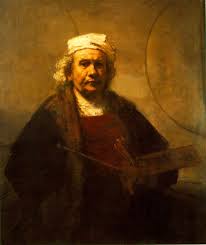 The first time I saw a reproduction of Rembrandt’s portrayal of Simeon with the Christ child (the late one, not the earlier one) it immediately became my favourite painting. It has all the fuzziness and limited palette associated with the artist’s late works, as well as all of the spiritual and emotional depth – it is the work of an artist for whom physical sight and the detail of appearance has taken second place to the ability see with the eyes of his heart and soul.
The first time I saw a reproduction of Rembrandt’s portrayal of Simeon with the Christ child (the late one, not the earlier one) it immediately became my favourite painting. It has all the fuzziness and limited palette associated with the artist’s late works, as well as all of the spiritual and emotional depth – it is the work of an artist for whom physical sight and the detail of appearance has taken second place to the ability see with the eyes of his heart and soul.
 In this painting, just as in his portrayal of the Return of the Prodigal Son (also a late work, and also featuring what could almost be the same model for the figure of the old man), he is depicting someone who, like the artist himself, is also seeing with the eyes of the soul. When you look at Simeon’s face, you know, somehow, that he is blind, and yet it is he who sees the baby Jesus for who he really is. When you look on the prodigal’s father, you know that he is seeing not the wreck that the young man has become, but the son he truly is, and will be again.
In this painting, just as in his portrayal of the Return of the Prodigal Son (also a late work, and also featuring what could almost be the same model for the figure of the old man), he is depicting someone who, like the artist himself, is also seeing with the eyes of the soul. When you look at Simeon’s face, you know, somehow, that he is blind, and yet it is he who sees the baby Jesus for who he really is. When you look on the prodigal’s father, you know that he is seeing not the wreck that the young man has become, but the son he truly is, and will be again.
 During his last years, Rembrandt returned several times to the project of painting self portraits. I often wonder whether in these two biblical old men he was somehow portraying himself, and whether, in all of these paintings, the self-portraits included, he was, in a way, learning to see himself with the eyes of the heart, and the soul, learning to see himself not in terms of his physical appearance, but in terms of who he truly was. Was he portraying, again and again, his true self, as he felt he was looked upon by God? And was he, then, in a very real sense, preparing for his own death?
During his last years, Rembrandt returned several times to the project of painting self portraits. I often wonder whether in these two biblical old men he was somehow portraying himself, and whether, in all of these paintings, the self-portraits included, he was, in a way, learning to see himself with the eyes of the heart, and the soul, learning to see himself not in terms of his physical appearance, but in terms of who he truly was. Was he portraying, again and again, his true self, as he felt he was looked upon by God? And was he, then, in a very real sense, preparing for his own death?
Simeon sees Jesus and immediately prays, ‘Lord, now lettest thou thy servant depart in peace’. Perhaps the reconciliation of the family is the last act of the prodigal’s father? In these last paintings, I see a man who has been through a great deal, and made many mistakes, and at the end of his life has learned to see himself for who he is.
Perhaps all this is a bit fanciful – one can never know the mind of an artist, and one of the great joys of art is that we can each look on it and see something different, something that reflects our own experience, our own questions, hopes, dreams or fears. But it was something of this that I had in my mind when I wrote, in my hymn for the Feast of Candlemas, “We come just as we are to you, as one who knows us through and through, and keeps us in your care, in love beyond compare.”
Simeon saw Jesus and recognised him, and at that moment, as Jesus gazed back with the intensity that only a baby can offer, he saw himself as God saw him: beloved. May we learn to do the same.
